As I have repeatedly shown in my articles, I am a fan of all aspects of fitness—not just strength and developing muscular mass, but also cardiovascular endurance and flexibility as well. You likely knew this already.
You are also likely aware that I have done several articles on stretching, most recently the “relax into stretch” technique that I state can be used predominantly for lower body stretching such as the splits, which are and will likely always be considered the benchmark of hip and leg flexibility.
But what about upper body flexibility? Most people don’t focus on that, and that is just as important to train as lower body flexibility (namely for purposes of increased athletic performance, reduction of joint aches and pains, and, in some cases, increased strength). I have taught the readers some basic upper body stretches in the past, such as the chest stretch and the door frame stretch. But in my opinion, if you’re going to do any one stretch for upper body flexibility, that would have to be the seated twist stretch.
How It Works
This stretch involves crossing your legs in a manner that will be discussed below, and twisting the torso while simultaneously locking your arm onto your bent knees. This stretch will hit most of your most prominent upper body muscles—the latissimus dorsi, the triceps, the deltoids, the obliques, the neck, and the pectorals.
In addition to those visible muscles, the twist stretch will work the deep spinal muscles, and even the muscles of the buttocks (the gluteus maximus, medius and minimus) as well.
Many athletes perform the twist stretch, particularly combat athletes such as wrestlers, judokas, and mixed martial artists that need great torso flexibility to escape from holds and pinfalls.
Sounds like something you ought to learn, doesn’t it? But how?
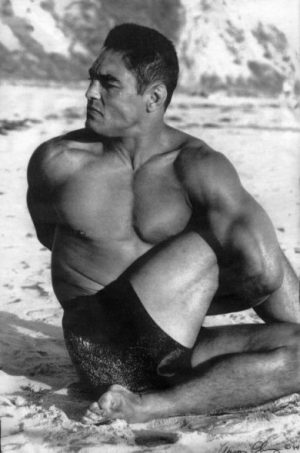
As I have happily admitted in the past, and will likely do so again, Paul Wade’s outstanding Convict Conditioning series has taught me this and many other exercises, and I cannot advocate Wade’s writing enough. More specifically, the Twist Stretch comes from Convict Conditioning 2. The first book deals with the core calisthenic series—push-ups, squats, and the like. I have already gone over these in detail. In contrast, the second book deals with static holds that develop strength and flexibility such as the L-Sit and today’s topic.
While the third book deals with explosive movements such as the back and front handsprings, that will be a topic for another time. Instead, let’s go into the steps of the Twist Stretch.
All of the pictures here are taken directly from the book.
The Exercises
The first twist stretch is the “Easy twist stretch.” Sit down on the floor with your feet extended. Take one foot, and put it “inside” the other leg, resting that foot next to the opposite knee, as shown.
Now, twist your body so the opposite shoulder turns towards the raised kneed (ie: if the left knee is raised, turn the right shoulder, and vice versa). Keep the foot flat on the ground and the knee stationary-just twist the torso. Allow your neck to turn as it naturally wants to turn.
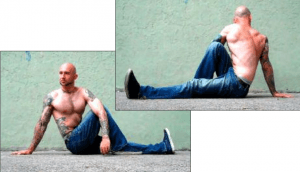
Then, “lock” your torso by placing your elbow against the opposite side of the knee, while holding your body up with the other hand.
You should immediately begin to feel a stretch all around your torso.
Hold the stretch for 10 seconds, for each side. When this is comfortable for you, move on.
Step 2 is the simple twist stretch, which requires a little bit more flexibility. Place one foot over the other leg as shown above. Then, take the foot that is not flat on the ground, bend the leg back and touch the heel of that foot to the opposing buttock (ie: the right heel touches the left buttock).
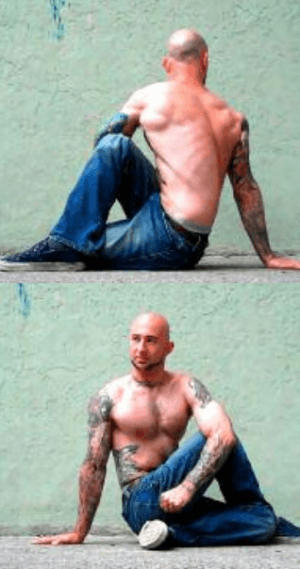
This foot position will be used for all twist stretches from henceforth.
Now, as before, rotate your torso towards the opposite knee (right shoulder to left knee, and vice versa), locking yourself by placing your elbow on the opposite side of the knee, and again supporting your body with the other hand. Hold for 10 seconds, and move on.
Stretch 3 is where things become more difficult. Assume the position from Stretch #2. But this time, you will have to rotate the torso with much more force, as the goal of this stretch is to extend your arm and touch the instep of the foot that is flat on the floor. Your arm won’t be able to stretch on its own (and I don’t advise you try), you will have to accomplish this with proper torso rotation.

Stretch 4 has the difficulty increase further: Get a hand towel or some other object that is about a foot long. Assume the stretching position, and rotate the torso while holding said towel. Remove the supporting hand from the floor, and flick the towel through the “hole” made by your raised leg (obviously your hand is not extending down to your instep here). Wrapping the “support” hand around your back, grab the other end of the towel. This begins the stretch.
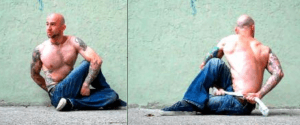
Each time you stretch, you will assume this position holding the towel in two hands. You will work your hands up and down the towel, slowly bringing your hands together by gripping greater portions of the towel. Eventually, you will be able to clasp fingers, and that is the final level of the twist stretch.
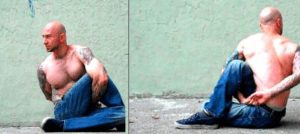
This process will be slow and arduous—“Coach Wade” himself admits that it took him the better part of a year to accomplish this by moving his fingers together inch by inch. I myself am not quite at the final level yet-a rough measurement shows that I have about 4 more inches of towel to go before my fingers touch, but I have certainly noticed increased mobility and flexibility already.
The towel stretch can be made easier by remembering to “worm” both hands up the towel, not just one. Actively use both to secure deeper stretches, and you will notice progress.
Doing even the easiest variations of this stretch will make you notice an immediate healing of the spine: your back will deliciously crack and you’ll feel warm and limber afterwards. And with practicing the more advanced variants, you will make yourself more limber for whatever physical activity you engage in, ranging from dancing to getting out of submission holds.
Or you could be one of millions of Americans with bad backs and hips. The choice is yours.
Read More: Why It’s Necessary To Relax Into A Stretch
WTF are there McDonald banner ads over the pics of athletic men? What irony
Reminds me of the old Marlboro Miles. If you smoke 800 cartons of cigarettes we will give you this kayak. LOL.
I remember those. The catalog was always full of stuff like kayaks, tents & rock climbing gear. My old man saved up & got a really nice throw blanket. RIP Marlboro miles & Camel cash.
Haha!
I can attest to the usefulness of this particular stretch being that I use it playing football/soccer and it affords me great flexibility and limberness.
As a guy with a job that requires him to stare at a computer screen for most of the day, this stretch always makes me feel super. I’ve worked with older guys who got hooked on pain meds for their backs, and eventually died from side effects from consuming too much oxycontin; this is one exercise that helps prevent that.
I also get excellent results from my foam roller. Even just lying flat (well, flat-ish) with the roller under my lumbar helps undo some of the damage from the standard desk chair.
That $10 lumbar pillow on my chair doesn’t exactly hurt, either.
Foam roll on the IT band is great. Hurts like a motherfucker at first but when you work on it consistently, eventually there’s no pain at all. Combine the twist stretch while sitting on the foam roll and rock forward and back on the glutes, I like that one.
I’ve gone past foam rolling and now use lacrosse balls. Wooah boy that hurt at first.
That’s a good one. Sometimes when I have a knot in my back I’ll lay on a baseball, put all my weight on it. Another great one is repeatedly stepping on a tennis ball or baseball for the arch. What do you use the lacrosse ball for? IT band?
ball on foot arch is awesome. I put the ball on the floor or against the wall and lean my muscle into it pretty much the same way you would use a foam roller. I also have a bunch of different sticks and things with wheels and spikes that I have collected over the years.
Sissy. I use the spiked ball from a medieval mace.
Google “Agile 8” for details.
The ball is used on the piriformis, which is a muscle under the glutes. Sit on the ball, under left butt cheek, put the left ankle on the right knee, roll around, cry if it’s a tight muscle…
Good times!
Nice, I’ll try it. Hurts bad enough with a foam roll.
Hurts like a bitch…
Try with a length of PVC pipe after a few months. REAL GOOD hurt… 🙂
I’m not a masochist, it works wonders and you only need it a few times a quarter. 🙂
Best option is to get rid of the chair and get a standing desk.
The latter seems definitely a good idea if the alternative is sitting most of the time.
However both can present problems.
That why I never both sit and stand at the same time.
My experience is that flexibility imbalances are likely to appear if most of the day is spent sitting and they can lead to a host of -apparently- unrelated issues.
Checking the flexibility of the leg muscles is a good idea.
This exercise used to be a lot more popular back in the day.
Today he barely registers as chubby.
Yeah used to be called the ‘playboy stretch’ even called that back in HS gym. Doubt they even have gym anymore.
I’ve got to get back to this stretch it was really helpful , I had to meet a yoga jap chick in Harlem and was relaxed about it, cause I was doing these types of stretches .yoga is very under rated for men . I get it if you don’t want to go to a studio or take a class , but it’s worth trying this stuff out on your own if you understand the technique .
Agreed about yoga. When you find a good yoga place that strips away all the hokey bullshit 1960’s fake mysticism that was invented so house wives could feel spiritual and breaks it down to component stretches it is excellent. If I had the time I would do a yoga class every day after my weight training. I do one time to time and use what I learn before and after for stretches though.
I also go to a Bikram yoga session once a month. 90 minutes of 105 degrees stretching. I don’t think I would be able to do it all the time but it feels great to do it now and then.
Anyone looking for spirituality or to use yoga as a primary for of exercise is going to be let down, but I agree…Yoga is underestimated for men…especially those who are already physical.
“yoga is very under rated for men”
Agreed.
Doing yoga on your own is not a good idea unless you have plenty of experience under your belt and a working knowledge of the human body and the inner workings of the asanas you perform.
I recently wrote about this topic for those weight lifters interested in limbering up.
If you train with heavy weights, yoga or a similar activity are a necessity.
I love this stretch. I can do maybe 50% of what the guys in some of these photos are doing but even at that it is so amazing.
This is as fairly standard exercise in most yoga classes that I have seen – and I have seen a few hundred over the past ten years. I would never have thought it had the benefits suggested for it here. It is certainly true that back injuries are the most common mechanical issues people report about their bodies. If this really helps that much, let’s start spreading the word.
It seems like an interesting stretch.
The only thing I don’t like much is the way the spine is twisted and compressed, judging from the photos.